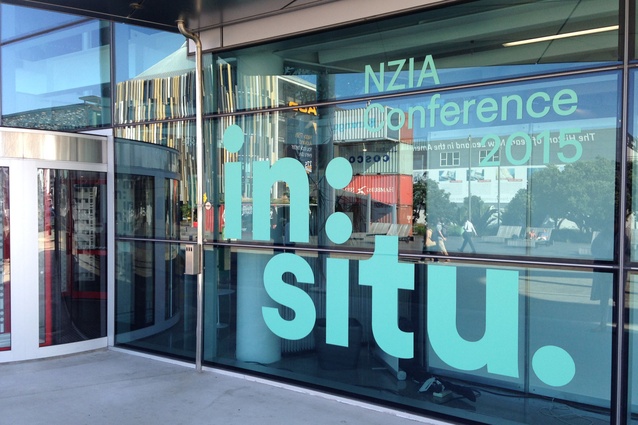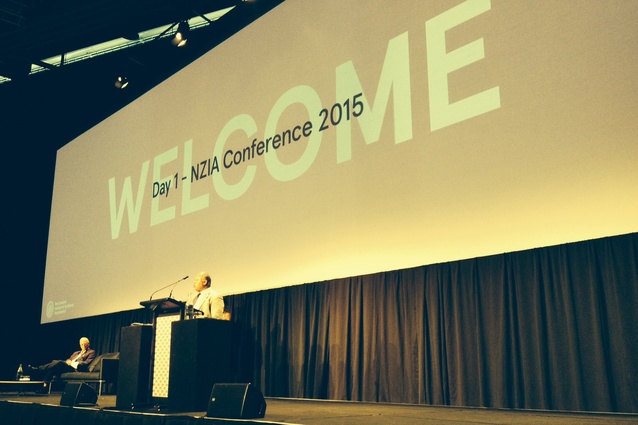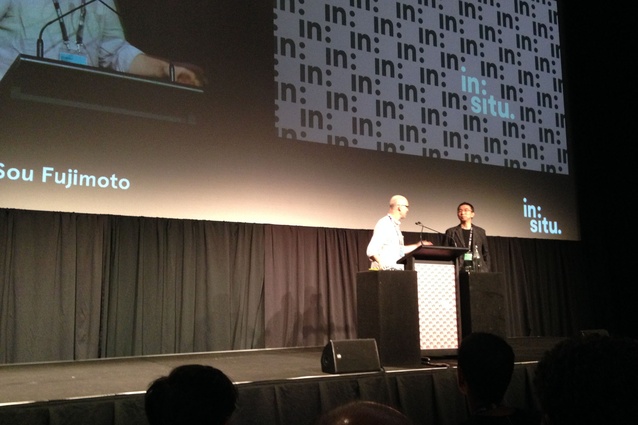in:situ 2015
Architecture students Sam Aislabie and Natalie Bradburn share highlights of the NZIA's annual conference.
Day one
Situating itself within Auckland’s most recently developed cultural precinct, Wynyard Quarter, the Viaduct Events Centre last night (Tuesday 10 February) staged the opening of what sets out to be a roaring few days. Greeted by a hallway of the usual trade-spec merchants; delegates, speakers and media alike streamed into the building. Adorned with the obligatory In:situ branded tote bags (unfortunately noticeably slender in content) participants mingled around well-endowed tables of refreshments. As Andrew Barrie so unashamedly pointed out, the entire architectural community of New Zealand might well be found within this single room.
A pōwhiri from Ngāti Whātua welcomed both local guests and those from abroad. After a few awkward hongis from our international guests, and a Waltzing Matilda sing along, led at last minute by Andrew Maynard, the conference was announced open and Sou Fujimoto took to the stage.
Fujimoto’s keynote lecture, Between Nature and Architecture, examined his recent projects and prospective works. There is an incredible skill and integrity in the way Fujimoto executes a single, simple idea to the absolute – be it the Musashino Art University Library, a building clad, lined and comprised entirely from bookshelves, or the 2013 Serpentine Pavillion, a finely orchestrated grid of steel bars duplicated into an ephemeral cloud, a kind of Sol Lewitt meets ‘Blur’ building.
Fujimoto suggests there is no limit to this scale of working and indeed, the Souk Mirage project is a testament to this. Seven mountain-sized towers of a repeated arch unit take this same gesture to a monumental scale – an architectural folly on steroids. This project in particular verged on being merely iconic; a building that could be constructed anywhere there is money to do so. Fujimoto even alluded to this, offering to build this project using “the cultural icon of anywhere” in place of the arch, a somewhat alarming proposition given the conference’s ‘insitu’ theme and its emphasis on context.
Nevertheless, the stand out project of the night was the Ichihara public toilet, an outhouse with no walls in an enclosed garden, which leaves the occupant in a wash room oasis. Here lies the real merit of Sou Fujimoto, in his interrogation of the way we live, creating architecture that challenges its users and resists the conventions of occupation.
By Sam Aislabie and Natalie Bradburn
Day two
“Perhaps Frank Gehry is a missing Kardasian- all curves, no content,” asserts Elizabeth Farrelly, one of the first speakers of day two at the 2015 NZIA Conference. A critic and columnist, Farrelly has performed the role of a sort of public intellectual, bringing debate on architecture and urbanism into the mainstream. Perhaps it is that Australians take city making more seriously, or the fact that critical voices in the New Zealand Herald are few and far between, but Farrelly’s talk certainly highlighted our lack of public provocateurs in the media - certainly none with her wit and charisma.
Despite being the most recent recipients of the Royal Institute of British Architects Gold Medal, I was, until recently, entirely unaware of the work of Sheila O’Donnell and John Tuomey. While their disposition was both humble and earnest, I must admit, I sunk a little when they announced they would be reading their lecture from script. The presentation that proceeded, however, was a poetic, nuanced and an incredibly rich meditation on architecture and their practice to date. Split into six chapters, the lecture unfolded like a compelling book, up there with any of the great architectural reads. They have a new devout follower.
Sarah Whiting’s lecture, while perhaps sitting in the shadow of the former, never the less delivered a cerebral and compelling argument for the recognition of object-lead design and its reconciliation with theory. However, her own firm’s work didn’t quite live up to her early assertions, feeling somewhat hollow and occasionally arbitrary.
The two panel sessions for the day looked to the edge of architectural practice, with a session on ‘the young and the unconventional’ followed by ‘Te Aranga Māori’. In the latter it would seem students are at the forefront, pushing Māori approaches to design boldly beyond cliches, as Rau Hoskins put it:“You can do anything if you take the people with you”.
As it turns out, cocktail hour does in no way indicate the presence of cocktails, but a few beers later and a jovial mood was set for the second international keynote speaker. Sam Jacob delivered a surprisingly optimistic talk on architecture as “the imagination made real and as real imagination”. Using Jay Z, Joy Division, Stanley Kubrick and Blake, Jacob argued architecture and pop-culture are all part of the same visionary machine and the term ‘post-modern’ wasn’t mentioned once!
After such a marathon of high calibre speakers, I imagine many may need time to digest and reflect on the lectures. I for one, am feeling invigorated and optimistic for the future of architecture and I’m sure I’m not alone.
By Sam Aislabie












